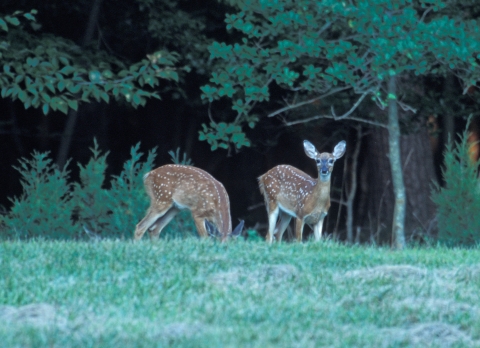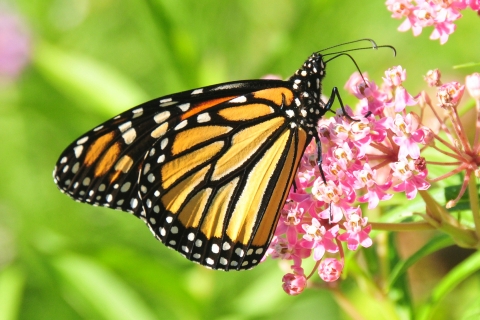Seasons of Wildlife
Spring
Spring is time for new growth and new beginnings! Amphibian species emerge from their winter retreats and move to their breeding sites, where loud breeding calls from gray tree frogs, spring peppers, and northern leopard frogs can be heard. Early pops of color are displayed by spring ephemerals like Canada mayflower or bloodroot scattered around. Migrant birds species make their arrival, such as turkey vultures, American woodcock, and chipping sparrows. Many species’ newborns like wobbly white-tailed fawns and tiny turkey poults are out exploring their new world at this time.
Summer
Summer is a bustling time for all species. The fields and meadows become an assortment of lush grasses and bright wildflowers, creating prefect habitat for many species, including groundhog and pollinators like monarch butterflys. Other insects like beetles, mosquitoes and grasshoppers become tasty meals for our bats, like the federally threatened and Massachusetts endangered, northern long-eared bat. Beavers and muskrats are very active forging, caring for young and repairing lodges. Waterfowl like Canada geese, wood ducks and mute swans are also raising their offspring in many different wetlands.
Autumn
Autumn is the calm after the hectic humid summer season. Migratory birds, like Great Blue Herons, Warblers, Wood Thrushes, and Broad-winged Hawks, leave for warmer wintering grounds. Many owls, including the barred owl, are more vocally active in fall, as juveniles and adults compete for territories. Other animals, from small red squirrels to big black bears, are searching for food to increase their fat reserves, or to store and secure their food supply for the upcoming winter months. White-tailed deer activity is at an all time high because of the breeding season called the "rut".
Winter
Winter is the quietest time of the year, yet wildlife is still all around us. Many songbirds, such as the stick around through the cold like our state bird, the black-capped chickadee and the ever-so-bright northern cardinal. Some animals, such as weasels and snowshoe hares even change their fur color to camouflage in the snow. North American river otters seen sliding down snowy hills and eating fish out on the ice is a common site. Even though we can’t see them, we have many hibernators such as groundhogs, insects, snakes, turtles, amphibians, and bats. One of our most impressive hibernators is the wood frog, who has special proteins in their blood which allows them to almost freeze entirely and then “defrost in the spring”.
Featured Species
The refuge helps conserve and protect wildlife and critical habitats surrounding the Sudbury-Assabet-Concord Rivers watershed. Many species, including migratory birds, as well as mammals, reptiles, amphibians, and insects. Special bird species such as the eastern towhee, grey catbird, scarlet tanager, Baltimore oriole, American woodcock, willow flycatcher, and the eastern kingbird, are found at the refuge. Another species Assabet River manages for is the Blanding’s turtle which is threaten in Massachusetts. Biologists are partnering with researchers to establish a larger, diverse population at the refuge.





